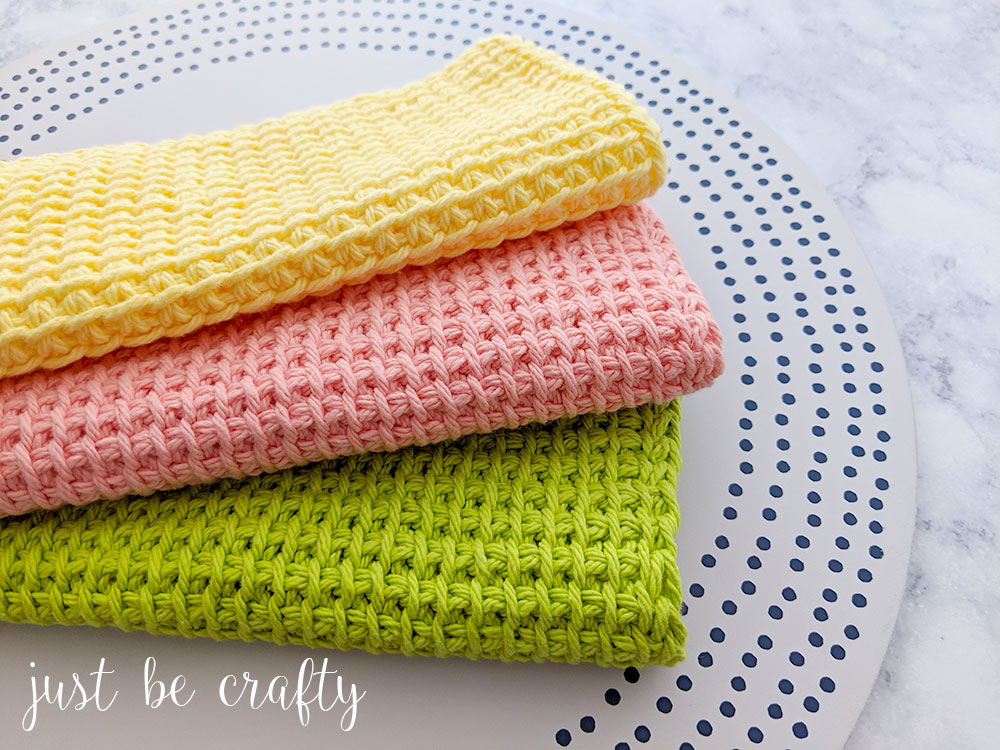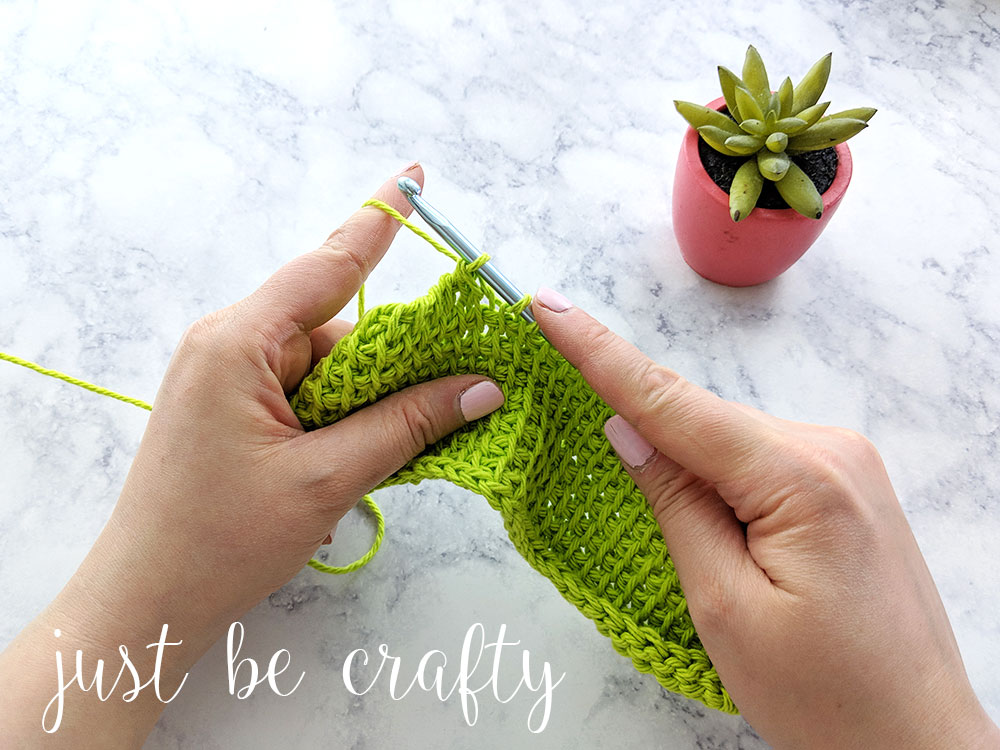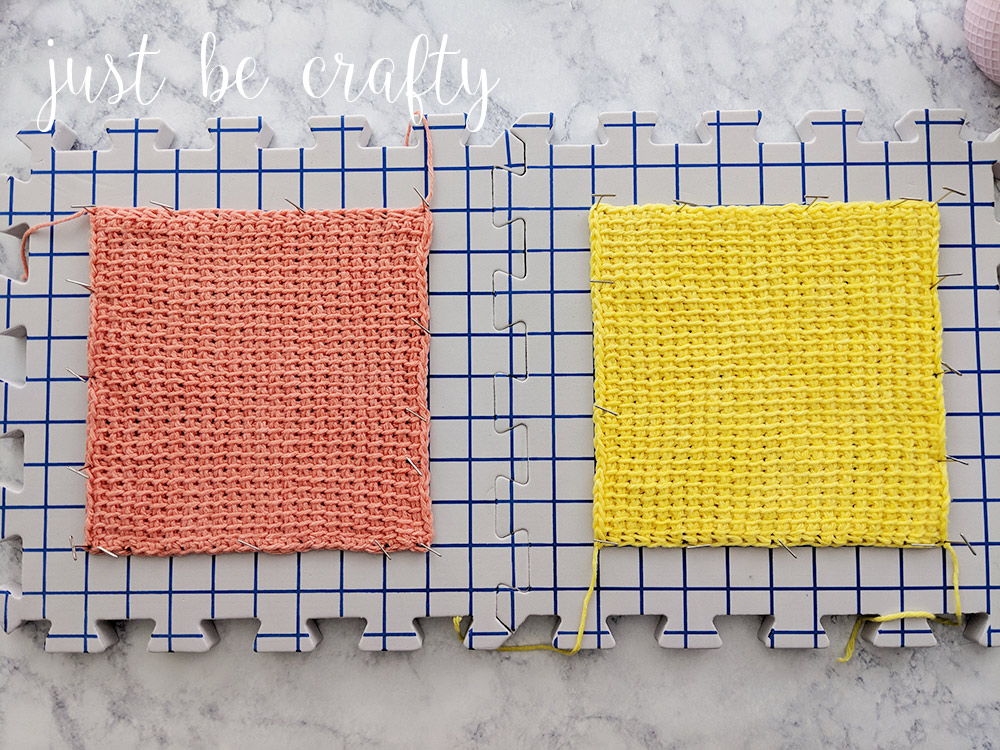The Tunisian Simple Stitch Dishcloth Pattern is the perfect project to get your feet wet in the world of Tunisian crochet. To learn more about this technique keep on reading below!
The ad-free printable version of this written pattern is available for purchase here.

Hello and happy Tuesday! Today I am sharing a brand new dishcloth pattern and video tutorial with you – the Tunisian Simple Stitch Dishcloth. I have been wanting to try out the Tunisian crochet technique for a while and I finally! If you haven’t tried it already and have been wanting to, you’re in the right place. To learn more about the Tunisian crochet technique, keep on reading below!
What is Tunisian Crochet?
Tunisian crochet is a hybrid technique that highly resembles knitting and can also be described as a mixture between the two crafts. The hook for Tunisian crochet is slightly different from a regular hook in that it’s basically a knitting needle with a crochet hook on the end. There are various stitch types in the world of Tunisian crochet but today we will be focusing on the Simple Stitch.
Tunisian crochet tends to run tighter than regular crochet and because of this, you may want to use a hook that is larger than what is recommended for your yarn and/or to be mindful to crochet looser than what you normally would. Because the stitches tend to run tighter than crochet, you will most likely see that your work curls.
Because your work will most likely curl it is super important that you take the time to wet block your project. In the pattern below I go over how to do this.

Simple Stitch
The fabric formed by Simple Stitch is a fairly thin but dense fabric that has minimal stretch. The stitch pattern forms a waffling effect that gives a great texture for an item such as a dishcloth or washcloth.
Each row of the simple stitch consists of two passes, working right to left and then left to right. The work is never turned when working this stitch.

In the first pass of a row, loops are drawn up through each stitch. At the end of the first pass, there will be a series of loops on the crochet hook and at this point the work resembles stitches on a knitting needle. The second pass of the row consists of yarning over and pulling through two loops at a time to complete the stitches in the row.

Video Tutorial
In this video tutorial I will show you exactly how to do the Tunisian Simple Stitch from start to finish. This technique looks complicated but it’s really is quite simple once you get the hang of it!
Tunisian Simple Stitch Dishcloth Pattern
The ad-free printable version of this written pattern is available for purchase here.
This post contains affiliate links. For more information please see my disclosures page.
Materials
- 1 ball of Lily Sugar’n Cream yarn (pictured in Hot Green, Tea Rose, and Yellow)
- 5.0mm Tunisian Crochet Hook
- yarn needle
- scissors
- blocking board kit
- oscillating fan (optional)
Finished Measurement
- Approximately 8 inches by 8 inches
Key
- ch – chain
- yo – yarn over
- BO – Bind off
Pattern
Chain 30
Row 1 – First Pass: Working in the back bars of your foundation chain, starting in the second chain from your hook, insert your hook, yo and draw up a loop on your hook, insert your hook into the next back bar, yo and draw up a loop; repeat this process across the row. Do not turn work.
Row 1 – Second Pass: yo, pull through 1st loop (counts as a chain), *yo, pull through 2 loops; repeat from * to end of the row. Do not turn work.
Row 2 – First Pass: One at a time, insert your hook into the front bars of each stitch, yo and draw up a loop, draw up a loop for each stitch across the row; for the last stitch draw up through the first chain of previous row. Do not turn work.
Row 2 – Second Pass: yo, pull through 1st loop (counts as a chain), *yo, pull through 2 loops; repeat from * to end of the row. Do not turn work.
Keep repeating the directions for Row 2 until your entire piece measures approximately 8 inches or the width of your dishcloth.
BO by inserting your hook into the bar of the next stitch, yo and draw up a loop, sl st. Repeat process across row. Cut yarn leaving at least a 6 inch tail. Secure.
Blocking

Soak your project in cool water with a small dab of laundry detergent for 10 – 15 minutes.

Take project out of soak and gently remove excess water. Do not wring project. Lay piece flat between two towels and press out remaining excess water.

Pin flat in place to finished measurements. If you have an oscillating fan, I suggest to place project near it in order to dry faster.

Once completely dry, remove from blocking board and weave in ends.

Enjoy!